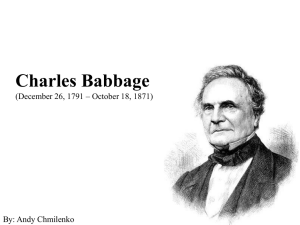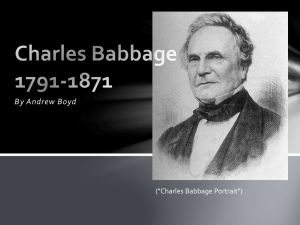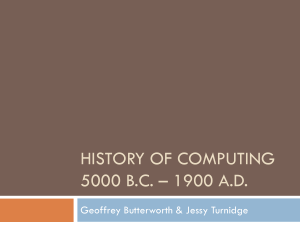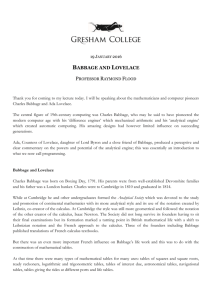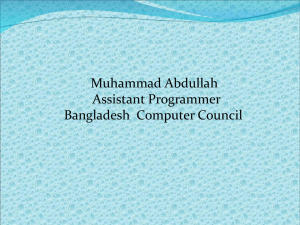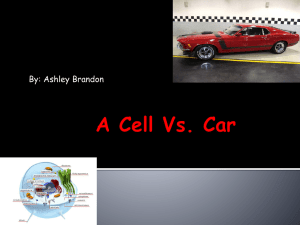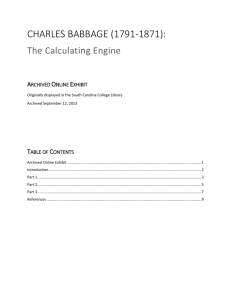large compute
advertisement
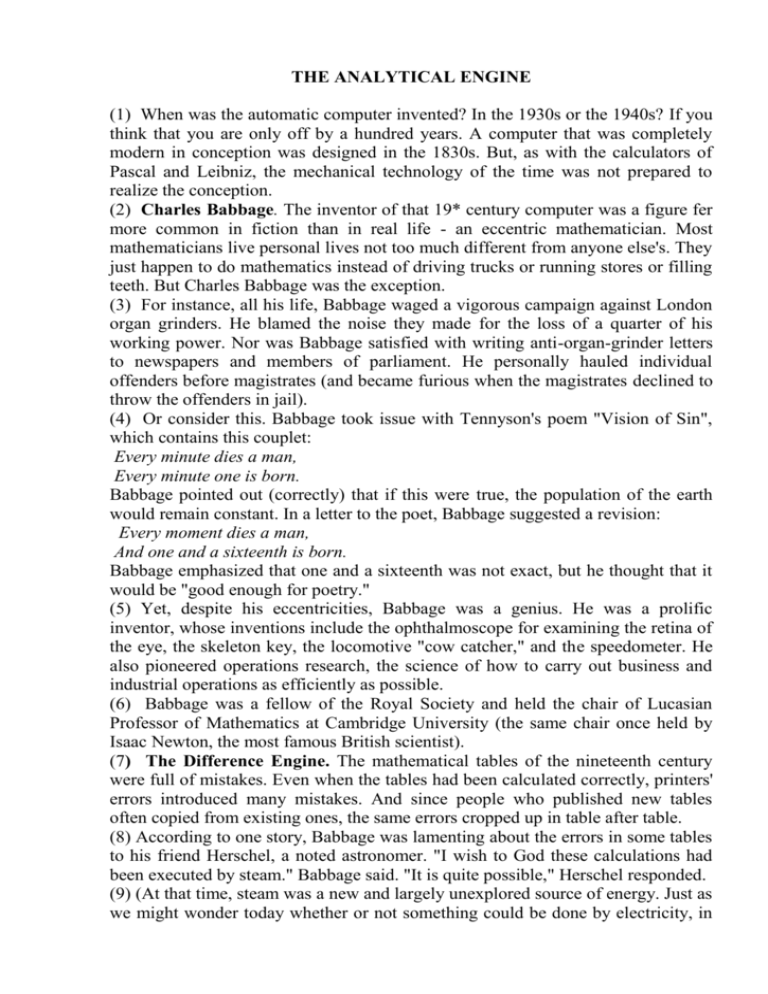
THE ANALYTICAL ENGINE (1) When was the automatic computer invented? In the 1930s or the 1940s? If you think that you are only off by a hundred years. A computer that was completely modern in conception was designed in the 1830s. But, as with the calculators of Pascal and Leibniz, the mechanical technology of the time was not prepared to realize the conception. (2) Charles Babbage. The inventor of that 19* century computer was a figure fer more common in fiction than in real life - an eccentric mathematician. Most mathematicians live personal lives not too much different from anyone else's. They just happen to do mathematics instead of driving trucks or running stores or filling teeth. But Charles Babbage was the exception. (3) For instance, all his life, Babbage waged a vigorous campaign against London organ grinders. He blamed the noise they made for the loss of a quarter of his working power. Nor was Babbage satisfied with writing anti-organ-grinder letters to newspapers and members of parliament. He personally hauled individual offenders before magistrates (and became furious when the magistrates declined to throw the offenders in jail). (4) Or consider this. Babbage took issue with Tennyson's poem "Vision of Sin", which contains this couplet: Every minute dies a man, Every minute one is born. Babbage pointed out (correctly) that if this were true, the population of the earth would remain constant. In a letter to the poet, Babbage suggested a revision: Every moment dies a man, And one and a sixteenth is born. Babbage emphasized that one and a sixteenth was not exact, but he thought that it would be "good enough for poetry." (5) Yet, despite his eccentricities, Babbage was a genius. He was a prolific inventor, whose inventions include the ophthalmoscope for examining the retina of the eye, the skeleton key, the locomotive "cow catcher," and the speedometer. He also pioneered operations research, the science of how to carry out business and industrial operations as efficiently as possible. (6) Babbage was a fellow of the Royal Society and held the chair of Lucasian Professor of Mathematics at Cambridge University (the same chair once held by Isaac Newton, the most famous British scientist). (7) The Difference Engine. The mathematical tables of the nineteenth century were full of mistakes. Even when the tables had been calculated correctly, printers' errors introduced many mistakes. And since people who published new tables often copied from existing ones, the same errors cropped up in table after table. (8) According to one story, Babbage was lamenting about the errors in some tables to his friend Herschel, a noted astronomer. "I wish to God these calculations had been executed by steam." Babbage said. "It is quite possible," Herschel responded. (9) (At that time, steam was a new and largely unexplored source of energy. Just as we might wonder today whether or not something could be done by electricity, in the early nineteenth century it was natural to wonder whether or not it could be done by steam.) (10) Babbage set out to build a machine that not only would calculate the entries in the tables but would print them automatically as well. He called this machine the Difference Engine, since it worked by solving what mathematicians call "difference equations." Nevertheless, the name is misleading, since the machine constructed tables by means of repeated additions, not subtractions. (11) (The word engine, by the way, comes from the same root as ingenious. Originally it referred to a clever invention. Only later did it come to mean a source of power.) (12) In 1823, Babbage obtained a government grant to build the Difference Engine. He ran into difficulties, however, and eventually abandoned the project. In 1854, a Swedish printer built a working Difference Engine based on Babbage's ideas. (13) The Analytical Engine. One of Babbage's reasons for abandoning the Difference Engine was that he had been struck by a much better idea. Inspired by Jacquard's punched-card-controlled loom, Babbage wanted to build a punchedcard-controlled calculator. Babbage called his proposed automatic calculator the Analytical Engine. (14) The Difference Engine could only compute tables (and only those tables that could be computed by successive additions). But the Analytical Engine could carry out any calculation, just as Jacquard's loom could weave any pattern. All one had to do was to punch the cards with the instructions for the desired calculation. If the Analytical Engine had been completed, it would have been a nineteenth-century computer. (15) But, alas, the Analytical Engine was not completed. The government had already sunk thousands of pounds into the Difference Engine and received nothing in return. It had no intention of repeating its mistake. Nor did Babbage's eccentricities and abrasive personality help his cause any. (16) The government may have been right. Even if it had financed the new invention, it might well have gotten nothing in return. For, as usual, the idea was far ahead of what the existing mechanical technology could build. (17) This was particularly true since Babbage's design was grandiose. For instance, he planned for his machine to do calculations with fifty-digit accuracy. This is far greater than the accuracy found in most modern computers and far more than is needed for most calculations. (18) Also, Babbage kept changing his plans in the middle of his projects so that all the work had to be started anew. Although Babbage had founded operations research, he had trouble planning the develop ment of his own inventions. (19) Babbage's contemporaries would have considered him more successful had he stuck to his original plan and constructed the Difference Engine. But then he would only have earned a footnote in history. It is for the Analytical Engine he never completed that we honor him as "father of the computer." (20) Lady Lovelace. Even though the Analytical Engine was never completed, a demonstration program for it was written. The author of that program has the honor of being the world's first computer programmer. Her name was Augusta Ada Byron, later Countess of Lovelace, the only legitimate daughter of the poet, Lord Byron. (21) Ada was a liberated woman at a time when this was hardly fashion able. Not only did she have the usual accomplishments in language and music, she was also an excellent mathematician. The latter was most unusual for a young lady in the nineteenth century. (She was also fond of horse racing, which was even more unusual.) (22) Ada's mathematical abilities became apparent when she was only fifteen. She studied mathematics with one of the most well known mathematicians of her time, Augustus de Morgan. At about the time she was studying under de Morgan, she became interested in Babbage's Analytical Engine. (23) In 1842, Lady Lovelace discovered a paper on the Analytical Engine that had been written in French by an Italian engineer. She resolved to translate the paper into English. At Babbage's suggestion, she added her own notes, which turned out to be twice as long as the paper itself. Much of what we know today about the Analytical Engine comes from Lady Lovelace's notes. (24) To demonstrate how the Analytical Engine would work, Lady Love lace included in her notes a program for calculating a certain series of numbers that is of interest to mathematicians. This was the world's first computer program. "We may say more aptly, Lady Lovelace wrote, " that the Analytical Engine weaves algebraical patterns just as the Jacquard-loom weaves flowers and leaves." Most aptly said indeed! EXERCISES I. Find in the text the English equivalents to: гораздо привычнее; эксцентричный математик; водить грузовик; держать магазин; винить за; развязать кампанию против; нарушитель; отклониться); оставаться постоянным; подчеркнуть (усилить); достаточно хороший; несмотря на; плодовитый изобретатель; отмычка; член королевского общества; сокрушаться об ошибках; выполнять при помощи пара; гений; изобретательный; столкнуться с трудностями; забросить проект; далеко впереди; начать сначала; по предположению; в два раза длиннее; удачно сказано! II. Answer the following questions: 1. What irritated and bored Charles Babbage? 2. Prove that Babbage was a prolific inventor. 3. What kind of machine was the Difference Engine? 4. What was the Babbage's reason for abandoning the project? 5. Contrast the Difference and the Analytical Engine. 6. Who has the honor of being the world's first computer programmer? 7. What do you know about Ada Lovelace (as a lady and as a programmer)? 8. Charles Babbage is a computer Guru, isn't he? III. Put the proper words into sentences effort, obsolete, track, arithmetic, device, mathematicians, construct, Engine. 1. The famous philosophers Leibniz and Pascal both ... somewhat primitive calculating... 2. After a great deal of time and..., a working model of the Difference … was... 3. Although the punched card is now becoming ..., it was of critical importance in the development of the computer. 4. An abacus is a... that allows the operator to keep ... of numbers while doing the basic ... operations. 5. A square-shaped wheel wouldn't be ... because it wouldn't roll easily. 6. Charles Babbage disliked doing the great amount of... that... had to perform in course of solving problems. 7. "Automating" means ... machines to do jobs that people do. IV. Construct other sentences in these patterns: 1. The inventor of the 19th century computer was a figure far more common in fiction than in real life. 2. They just happen to do mathematics instead of filling teeth. 3. Despite his eccentricities, Babbage was a genius. 4. If this were true, the population of the earth would remain constant. 5.1 wish to God these calculations had been executed by steam. 6. We might wonder today whether or not something could be done by nuclear energy. 7. The government had no intention of repeating its mistakes. Nor did Babbage's abrasive personality help his cause any. 8. Even though the Analytical Engine was never completed, the program for it was written. 9. Her notes turned out to be twice as long as the paper itself. 10. It is for Analytical Engine he never completed that we honor B PREHISTORY (1) Tools are any objects other than the parts of our own bodies that we use to help us do our work. Technology is nothing more than the use of tools. When you use a screwdriver, a hammer, or an axe, you are using technology just as much as when you use an auto mobile, a television set, or a computer. (2) We tend to think of technology as a human invention. But the reverse is closer to the truth. Stone tools found along with fossils show that our ape-like ancestors were already putting technology to use. Anthropologists speculate that using tools may have helped these creatures evolve into human beings; in a tool-using society, manual dexterity and intelligence count for more than brute strength. The clever rather than the strong inherited the earth. (3) Most of the tools we have invented have aided our bodies rather than our minds. These tools help us lift and move and cut and shape. Only quite recently, for the most part, have we developed tools to aid our minds as well. (4) The tools of communication, from pencil and paper to television, are designed to serve our minds. These devices transmit information or preserve it, but they do not modify it in any way (If the information is modified, this is considered a defect rather than a virtue, as when a defective radio distorts the music we're trying to hear.) (5) Our interest lies with machines that classify and modify information rather than merely transmitting it or preserving it. The machines that do this are the computers and the calculators, the so-called mind tools. The widespread use of machines for information processing is a modern development. But simple examples of information-processing machines can be traced back to ancient times. The following are some of the more important forerunners of the computer. (6) The Abacus. The abacus is the counting frame that was the most widely used device for doing arithmetic in ancient times and whose use persisted into modem times in the Orient. Early versions of the abacus consisted of a board with grooves in which pebbles could slide. The Latin word for pebble is calculus, from which we get the words abacus and calculate. (7) Mechanical Calculators. In the seventeenth century, calculators more sophisticated than the abacus began to appear. Although a number of people contributed to their development, Blaise Pascal (French mathematician and philosopher) and Wilhelm von Leibniz (German mathematician, philosopher, and diplomat) usually are singled out as pioneers. The calculators Pascal and Leibniz built were unreliable, since the mechanical technology of the time was not capable of manufacturing the parts with sufficient precision. As manufacturing techniques improved, mechanical calculators eventually were perfected; they were used widely until they were re placed by electronic calculators in recent times. (8) The Jacquard Loom. Until modern times, most information-processing machines were designed to do arithmetic. An outstanding exception, however, was Jacquard's automated loom, a machine de signed not for hard figures but beautiful patterns. A Jacquard loom weaves cloth containing a decorative pattern; the woven pattern is controlled by punched cards. Changing the punched cards changes the pattern the loom weaves. Jacquard looms came into widespread use in the early nineteenth century, and their descendants are still used today. The Jacquard loom is the ancestor not only of modern auto mated machine tools but of the player piano as well. EXERCISES I. True or false? 1. The strong will inherit the earth. 2. In the beginning was the abacus. 3. The forerunner of the computer is the mechanical calculator. 4. The punched card is still very important for computers today. 5. The calculators Pascal and Leibniz built were reliable. 6. The mechanical calculator could multiply and divide as well as add and subtract. 7. Babbage invented the Jacquard loom. 8. "Beware of programmers who carry screwdrivers". (L. Brandwein) П. Give synonyms to: To aid, strength, to speculate, nothing more than, to lift, ancestors, to manufecture, to single out, precision, to perfect, in recent times, pattern, to develop, informationprocessing machine. Ш. Give antonyms to: Descendants, automated machine, exception, virtue, intelligence, to transmit, reliable, sufficient, in the early 19th century, in the modem times. STRAP ON SOME EYE PHONES AND YOU ARE VIRTUALLY THERE (1) One of the most exciting new areas of computer research is virtual reality. Having been featured in TV sitcoms as well as public television documentaries, virtual reality is merely an ambitious new style of computer interface. Virtual reality creates the illusion of being in an artificial world — one created by computers. (2) Virtual reality visitors strap on a set of eye phones. 3-D goggles that are really individual computer screens for the eyes. Slip ping on the rest of the gear allows you not only to see and hear, but also to sense your voyage. The world of virtual reality has been called cyberspace, a computer-enhanced fantasy world in which you move around and manipulate objects to your mind's content. (3) When you move your head, magnetic sensors instruct the computer to refocus your eye phones to your new viewpoint. Sounds surround you. and a fiber-optic glove allows you to "manipulate" what you see. You may seek out strange new worlds, fight monsters in computer combat, or strap yourself into the seat of a Star Wars-type jet and scream through cyberspace, blasting all comers to oblivion (computer oblivion, at least). Or. with your stomach appropriately settled, you might even try out the most incredible roller coaster ride vou will ever take in your life. (4) For the disabled, virtual reality promises a new form of freedom. Consider the wheelchair bound paraplegic child who is suddenly able to use virtual reality gear to take part in games like baseball or basketball. Research funded by the government takes a military point of view, investigating the possibility of sending robots into the real conflict while human beings don cyberspace gear to guide them from back in the lab. (5) Spectrum Holobyte, a computer games development company, announced its first virtual reality computer game for the home during 1991 Christmas season. Imagine yourself suddenly clutching your handheld laser pistol as a giant bird swoops right at you from the age of inosaurs! Your laser shot goes astray, and you feel yourself suddenly lifted off the ground and carried higher and higher. That's enough - for some of us it can be virtually too real. EXERCISES I. True or false? 1. Virtual reality is a computer-built fantasy world. 2. Virtual reality is also called cyberspace. 3. There are no limits to virtual reality. 4. Virtual reality is created by being in a special room. 5. Virtual reality is available only on expensive computer systems. 6. Virtual reality is the leading edge of the computer technology. 7. Eye phones are the 3DFX fiber-optic glasses. 8. Eye phones are not the only virtual reality gear. 9. Virtual reality might be misused. 10. Virtual reality can return the disabled to the full-fledged life. II Read the words as they are used in the following sentences and try to come up with your own definition: 1. Using computers to create graphics and sounds, virtual reality makes the viewer believe he or she is in another world. 2. Three-dimensional images are created using technology that fools the viewers' mind into perceptive depth. 3. Plug a terminal directly into the brain via a prepared skull and you can enter cyberspace. 4. I've got a set of eye phones, 3D goggles, a fiber optic glove and the rest of the gear. 5. There are many word substitutes for invalids, e.g. the handicapped challenged by birth or by accidents, disabled people. 6. The bowman took a deep breath, aimed at the target and shot, but the arrow went astray. Virtual reality —__________________ Three-dimensional (3D) —__________________ Cyberspace —___________ Gear— _______________ Disabled—____________ To go astray —__________ III. Put the proper words into sentences: a) fiber-optic, swoop, go astray, clutching, gear, to one's mind, content, enhance, cyberspace, eye phones. 1. Virtual reality is sometimes called... 2. 3-D ... are really individual computer screens for the eyes. 3. Virtual reality can... possibilities of the disabled. 4. The manual... box allows you to slow down without braking, while the automatic one doesn't. 5. Cyberspace allows everybody to change it... 6. The letters wrongly addressed... 7. ... unknown things may cause an accident. 8. By the end of the 20th century metal wires had been replaced by ones. 9. In one of the s the NATO has lost their most expensive fighter. b) be, have, see, do, leave, write, tell 1. It was more than a hundred years ago that Lewis Carroll... about Alice's trip through the looking glass. 2. Now that fiction ... became a reality ... or you might say, a virtual reality ... because that's the name of a new computer technology that many believe will revolutionize the way we live. 3. Trainees fighting in virtual battles often cannot... a man from a machine. 4. Virtual reality lets you travel to place you've never ..., do things you've never ... without... the room. 5. Some day, you will... that virtual reality makes other forms of entertainment, such as TV and movies, obsolete. A MAN / MACHINE SYSTEM Any form of tool or complex machine which is used by a man forms a man/machine system. The purpose of the system may be to get a man or goods from one place to another; it may be to communicate, or it may be to manufacture some useful objects or to mine coal out of the ground. Here we try to describe a man/ machine system as the machine becomes more complex and relieve the man of many mechanical tasks. Level 1 is the simple machine in which a man provides the power as well as the controlling skill. Some examples are the woodman's axe, the carpenter's saw, mallet and chisel, and the hand-pulled or -pushed cart, trolley. The tool or machine can be regarded as an extension of the man's body since he grasps it firmly and guides its motion directly with his own muscular effort. Level 2 is the powered machine or tool. The power may come, for example, from an animal as in the case of a horse-drawn cart, from wind as for the sailing ship and the windmill. Here the man is fully responsible for controlling the system but he requires devices such as switches, pedals and steering wheels to control the power system. Level 3 is simple automation. The single-process machine or a tool with built-in auto-control can perform any process whenever it is fed with raw materials by the operator. It has its own source of power. An example is the automatic lathe in use early in the 20 th century. Level 4 is the man extender. These are the machines which carry out complex programmes for which they are instructed by the man. But they only do these when a man is telling them to do that particular job. One example in use at present is the digital computer which is capable of doing very quickly any operation of very great complexity. Level 5 is the robot. This is the system which is powered and programmed to produce a succession of identical products or carry out a series of similar operations. The human can instruct the robot to vary its actions in accordance with variations which it observes in 'the surrounding situation. I. Read the text right through and decide where the following sentences fit in it. Put a number 1-6 in the boxes. a. □ A skilled mechanic had to set up the cams for each new job of a lathe. b.□ In any of the cases mentioned above the humans provide the objective, design and build the machines, supervise and maintain them. c. □ It is sure to have a memory for a series of operations it has been instructed to do, a method of instructing this memory by the human, and a mechanical manipulating device. d.□ When using a mallet and chisel one hand controls the position and threedimensional orientation of the chisel while the other controls very accurately the blows of the mallet (direction, momentum, frequency). e. □ But they only do these complex programmes when a man is connected to them in «real time», at least as far as telling t hem to do that particular job. f. □ The power may come from the internal combustion engine as for the car or from an electric motor as for a power drill. II. Read the text right through and match each underlined word in column A with its probable meaning in column B. Be careful, there are some extra meanings in column B. Column A Column B 1. .... the machine relieves the man of many a. the coming of one thing af ter another in time or order mechanical tasks. b. expertness 2. .... a man provides the power as the c. can be thought of as well as the controlling skill. d. with respect to 3. Some examples are mallet and chisel e. rescues 4. The tool can be regarded as an extension of the f. a hammer with a short handle and a large wooden head man’s body … and a tool with a steel edge for cutting or shaping wood 5…. whenever it is fed with raw materials. g. a machine that holds and turns articles of wood, metal, etc 6. An example is the automatic lathe in use… h. in agreement with 7…. to produce a succession of identical products … i. supplied 8. … to vary its actions in accordance with variations… j. frees k. makes less monotonous l. a tool for cutting made of thin, steel blade with sharp teeth on the edge m. a tool for chopping wood III. Read the text and write true (T) or false (F) for each of the sentences below, according to the information given. If the information is not given, put the question mark (?). 1. □ Machines whose input is a natural source of energy are called powered machines. 2. □ A machine is a device that transmits and changes force or motion into work. 3. □ A digital computer is an electronic device capable of doing numerical calculations very quickly. 4. □ Both the woodman's axe and the carpenter's saw are examples of the powered machine. 5. □ An automatic capstan lathe used at the beginning of the 20 th century had a drum beneath it carrying out the series of capstan operations. 6. □ A trolley and a horse-drawn cart can serve as the examples of a simple machine in which a man provides both the power and the controlling skill. 7. □ An industrial robot is sure to have a memory for a series of operations it has been instructed to do by the human. 8. □ The aim of the man/machine system may be to communicate as in the case of a telephone system. IV. Read the text right through and then choose the best answer for each of the following. 1. A man/machine system is a. an extension of the man's body; b. a complex machine used by a man; c. a mechanical manipulating device. 2. The purpose of a man/machine system is a. to provide the objective, design and build the machines; b. to supervise and maintain the machines; c. to manufacture some useful objects. 3. For controlling the power system of the powered machine or tool a man requires devices such as a. mallet and chisel; b. switches and pedals; c. nuts and screws. 4.There are a lot of machines or tools whose input is a natural source of energy including a. wind and water; b. steam and petroleum; c. an alternating current of electricity. 5. The systems powered and programmed to produce a succession of identical products or carry out a series of similar operations are called a. men extenders; b. powered machines; c. robots. 6. Machines capable of processing large amounts of data very quickly are known as a. industrial robots; b. internal combustion engines; c. computers. 7. A man provides the power and the control in operating a. the man extender; b. the simple machine; c. the robot. 8. A tool with built-in auto-control is an example of a. the single-process machine; b. the man extender; c. the powered machine. V. Choose the correct questions to the following statements. 1. The purpose of the man/machine system may be to manufacture some useful objects. a.What is the purpose of the man/machine system? b.What may the purpose of the man/machine system be? c.May the purpose of the man/machine system be to manufacture some useful objects? 2. The machine relieves the man of many mechanical tasks. a.What does the machine do for the man? b. What sort of tasks does the machine relieve the man of? c. The machine relieves the man of many mechanical tasks, doesn't it? 3. The power may come from an animal as in the case of a horse-drawn cart. a.Where may the power come from? b. May the power come from an animal or from the internal combustion engine? c.What makes a horse-drawn cart move? 4. The man requires devices such as switches, pedals and steering wheels to control the power system. a. Who requires devices such as switches, pedals and steering wheels to control the power systern? b. What does the man require to control the power system? c. What sort of devices does the man require to control the power system? 5. The single-process machine can perform any process whenever it is fed with raw materials by the operator. a. Who can the single-process machine be fed with raw materials by? b. When can the single-process machine work? c. I wonder if the single-process machine can perform any process whenever it is fed with raw materials by the operator? 6. The digital computer is capable of doing very quickly any operation of very great complexity. a. What is the digital computer capable of doing very quickly? b. What kind of computer is capable of doing any operation of very great complexity? c. Is the digital computer capable of doing very quickly any operation or only operations of very great complexity? Why I Won’t Buy A Computer. (1) I do not see that computers are bringing us one step nearer to anything that does matter to me: peace, economic justice, ecological health, political honesty, stability, good work. (2) What would a computer cost me? More money than I can afford, and more than I wish to pay to people whom I do not admire. But the cost would not be just monetary. It is well understood that technological innovation always requires the discarding of “the old model”, what would be superseded would be not only something, but somebody. (3) To make myself as plain as I can, I should give my standards for technological innovations in my work. They are as follows: - The new tool should be cheaper than the one it replaces. - It should be at least as small in scale as the one it replaces. - It should work clearly and demonstrably better than the one it replaces. - It should use less energy. - If possible it should use some form of solar energy. - It should be repairable by a person of ordinary intelligence, provided he has the necessary tools. - It should be purchasable and repairable as near to home as possible. - It should come from a small, privately owned shop or store that will take it back for maintenance and repair. - It should not disrupt or replace anything good that already exists, and this includes family and community relationships. Exercises I. Answer the following questions: 1. What does the author think a computer would “cost” him? 2. Give the author’s standards for technological innovation, what other new tools do you think he might object to? 3. How has technology changed your everyday life? 4. What new “gadgets” do you particularly like? 5. Have you learned to use a computer? Why or why not? 6. Do you fear the power of computers? 7. List the ten modern inventions: Invention I Replacement I Advantage I Disadvantage electricity telephone writing letters less time silicon chip cellular phone too slow 8. True or false? - Modern technology is out of control, and ruining the quality of life on Earth; we must limit technology and its influence on individual. - Modern inventions are labor-saving devices. Without them people remain slaves to boring, repetitive work. 9. How will science and technology affect our lives in future? II. Complete the following and discuss it: 1. Scientific and technological breakthroughs have brought great benefits. You only have to look around your own home to see … 2. Many illnesses can now be treated or cured, for example, … 3. Other examples of changes are … 4. Have our lives always been improved, however? Have we become too passive? Are we too dependent on technology? How dangerous could it be? 5. Take, for example, television, computer games, the Internet … 6. New products have also made a major difference to our working lives. 7. Nowadays … 8. In the future there may be even more major breakthroughs in the fields of medicine, leisure, work… 9. We may no longer have to/// 10. We will be able to… WORRY ABOUT COMPUTERS? ME? (1) When your computer is turned off. it is a dead collection of sheet metal, plastic, metallic tracings, and tiny flakes of silicon. When you hit On switch, one little burst of electricity — only about 5 volts — starts a string of events that magically brings to life what otherwise would remain an oversize paperweight. (2) At first the PC is still rather stupid. Beyond taking inventory of itself, the newly awakened PC still can't do anything really useful, intelligent. At best it can search for intelligence in the form of operating system that gives structure to the PC's primitive existence. Then comes a true education in the form of application software — programs that tell it how to do tasks faster and more accurately than we could, a student who has outstripped its teacher. (3) What makes your PC such a miraculous device is that each time you turn it on, it is a tabula rasa, capable of doing anything your creativity — or, more usually, the creativity of professional programmers — can imagine for it to do. It is a calculating machine, a magical typewriter, an unerring accountant, and a host of other tools. To transform it from one persona to another requires setting some of the microscopic switches buried in the hearts of the microchips, a task accomplished by typing a command in DOS prompt or by clicking with your mouse on some tiny icon on the screen. (4) Such intelligence is fragile and short-lived. All those millions of microscopic switches are constantly flipping on and off in time to dashing surges of electricity. All it takes is an errant instruction or a stray misreading of a single chip to send this wonderfully intelligent golem into a state of catatonia or hit the Off switch and what was a pulsing artificial life dies without a whimper. Then the next time you turn it on, birth begins all over again. (5) PCs are powerful creations that often seem to have a life of their own. Usually they respond to a seemingly magic incantation typed as a C:>prompt or to wave of a mouse by performing tasks we couldn't imagine doing ourselves without some sort of preternatural help. There are the times when our PCs rebel and open the gates of chaos onto our neatly ordered columns of numbers, our carefully made sentences, and our beautifully crafted graphics. Are we playing with power not entirely under our control? (6) A middle-aged woman sat down at a personal computer for the first time in her life. She placed her hands above the keyboard, ready to type — but hesitated. Turning to the instructor, she asked warily: "It won't know what I'm thinking, will it?" Such concerns abound among people whose knowledge of computers comes from movies like 2001: A Space Odyssey (in which Hal, the computer with the sticky-sweet voice, tries to take control of the spaceship). Terms such as computer anxiety and computer phobia have entered our language to describe such wariness. Many people try to avoid situations in which they might be forced into contact with computers. Even businesspeople who deal with computers daily may experience a form of cyberphobia — fear of computers. As a result of their fear, some office workers who are cyberphobic suffer nausea, sweaty palms, and high blood pressure. Young people who have grown up with computers may not understand these reactions. (7) What are such people afraid of? Some may worry about the mathematical implications of the word computer. It seems to suggest that only a person with strong analytical and quantitative skills can use the machine. In fact, as we see more and more often, even very young children whose math skills have yet to form can use computers. (8) Some people are fearful of the computing environment. The movies love to portray old-fashioned, large computer systems — sanitized rooms walled by machines alive with blinking lights and spinning reels; it all looks intimidating. There is a notion that computers are temperamental gadgets and that, once a glitch gets into a computer system, it may wreak all kinds of havoc — from fouling up bank statements to launching nuclear missiles by mistake. Indeed, computer billing and banking errors are problems; however, most errors blamed on computers are the result of mistakes made by people. Computers do not put in the data they must work with, people do. Even so, correcting an error can be frustratingly slow. (9) Many people worry about computers in relation to their jobs. Some people doubt they have the skills to find jobs and keep them in a technological labor market. Many feel that keeping up with the swift pace of technological change is impossible because it requires costly and continuous training and development. A good many present-day executives whose companies have installed computer terminals in their offices also worry about typing — either they do not know how to type or they are afraid they will lose status if they use a keyboard. (10) Interestingly, there is another side to computer anxiety: the fear of being left out or left behind. If everyone around you is talking about, living with, and working around computers, how can you keep from revealing your limited understanding? (11) People are also nervous that computers might fall into the wrong hands. As examples of electronic wrongdoing, try these for size: An "error" purposefully introduced into your computerized credit report by someone who wanted to cause you trouble might do irreparable damage to your financial standing, ending any hopes you might have for owning a home someday. An easily obtainable computerized list might carry personal information that could lead to an invasion of your privacy or at the least, a pile of junk mail. Think of all the forms you have filled out for schools, jobs, doc tors, credit services, government offices, and so on. There is scarcely one fact related to you that is not on record in a computer file somewhere. Could unauthorized persons obtain this information? (12) Computer fraud and computer security are not simple issues; they are concerns that society must take seriously. Should we, as computer columnist John Dvorak advocates, let things work themselves out in the courts? Or, should legislators be encouraged to create laws for society's protection? EXERCISES I. Find in the text the English equivalents to: деловые люди; страх перед компьютерами; испытывать тошноту; высокое кровяное давление; математический смысл (значение); старомодные компьютерные системы; выглядеть устрашающе; мерцающие огни; вращающиеся катушки; временные приспособления; по ошибке; обвинять компьютеры; исправлять ошибки; установить терминалы; использовать клавиатуру; потерять статус; попасть в «дурные» руки; нанести непоправимый ущерб; невостребованная почта; заполнить бланк; записать в компьютерный файл; создать законы для защиты общества. II. True or false? 1. People are not interested in computers, they just don't want to be left behind. 2. Computers are going to make many careers obsolete. 3. Most jobs will be lost because of computers. 4. Computers change the way jobs are performed. 5. People who refuse to have anything to do with computers may soon be regarded as people who refuse to learn to drive. 6. Computers are powerful, potentially dangerous tools with a life of their own. 7. Most of businesspeople write or commission their own programs. 8. Computers are now smaller and more powerful than ever before. 9. Computers have resulted in massive unemployment in many countries. 10. Managers with little or no computer experience should over rely on computers. 11. Computers can result in an invasion of people's privacy. 12. Today the challenge is to manage the information explosion through the use of well-designed information. 13. Data = information. 14. Computerization leads to elimination of workers'jobs (robots) and white-collar jobs (computers). 15. The bank computer thefts are carried out by computer whizzes who know the correct codes to use to access accounts in order to steal or manipulate money. 16. In a few seconds computer can make a mistake so great that it would take many months to equal it. 17. Computer monitoring of people leads to job stress and more frequent illnesses. 18. One person's error is another person's data. 19. To err is human; to really foul things up requires a computer. III. Give definitions to: a computer whiz (whizard), a hacker, a computer-literate person, a computer science student, a computer engineer, a computer programmer, a computer operato., e.g. a system analyst is a person who identifies the information needed and develops a management info system with the assistance of computer programs. IV. Give synonyms to: swift, costly, financial standing, to introduce into, to obtain, issue, to concern, tiny, magic, artificial, to turn on, accurately, anxiety, fear, to lead to, old-fashioned command, to spin, to require. V. Put the proper words into sentences mistakes/errors, time, use/operation, improving, human, are, accuracy, so, part/role, make, involved, since, back, ever, replaced, more. FEED IN ENGLISH, PRINT OUT IN FRENCH Once upon a ..., according to a much told story, a computer was set a task of translating "traffic jam" into French and back into English. The machine buzzed, clicked, blinked its lights and eventually came up with "carflavored marmalade". Machine translation has come a long way ... then. Computer translation systems are now in... in many parts of the world. Not surprisingly, the EEC is very .... With so many official languages, translating and interpreting take up ... than 50% of the Community's administrative budget. But although the efficiency of machine translation is ... rapidly, there's no question of... translators being made redundant. On the contrary, people and machines work together in harmony. Today's computers ... of little value in translating literary works, where subtlety is vital, or the spoken word, which tends to be ungrammatical, or important texts, where absolute ... is essential. But for routine technical reports, working papers and the like, which take up ... much of the translation workload of the international organizations, computers are likely to play an increasing.... The method of operation will probably be for the machines to ... a rough version, which the translator will then edit, correcting obvious ..., and where necessary referring ... to the original. If machines can translate languages, could they ... teach languages? Yes say enthusiasts, although they doubt that the teacher could ever be totally ... by a machine in the classroom. Good old teachers know best! BABBAGE'S DREAM COME TRUE (1) The Harvard Mark I. A hundred years passed before a machine like the one Babbage conceived was actually built. This occurred in 1944, when Howard Aiken of Harvard University completed the Harvard Mark I Automatic Sequence Controlled Calculator. (2) Aiken was not familiar with the Analytical Engine when he designed the Mark I. Later, after people had pointed out Babbage's work to him, he was amazed to learn how many of his ideas Babbage had anticipated. (3) The Mark I is the closest thing to the Analytical Engine that has ever been built or ever will be. It was controlled by a punched paper tape, which played the same role as Babbage's punched cards. Like the Analytical Engine, it was basically mechanical. How ~ ever, it was driven by electricity instead of steam. Electricity also served to transmit information from one part of the machine to another, replacing the complex mechanical linkages that Babbage had proposed. Using electricity (which had only been a laboratory curiosity in Babbage's time) made the difference between success and failure. (4) ENIAC. What was needed was a machine whose computing, control, and memory elements were completely electrical. Then the speed of operation would be limited hot by the speed of mechanic-cal moving parts but by the much greater speed of moving electrons. (5) In the late 1930s, John V. Atanasoff of Iowa State College demonstrated the elements of an electronic computer. Though his work did not become widely known, it did influence the thinking of John W. Mauchly, one of the designers of ENIAC. (6) ENIAC — Electronic Numerical Integrator and Computer - was the machine that rendered the electromechanical computers obsolete. ENIAC used vacuum tubes for computing and memory. For control, it used an electrical plug board, like a telephone switchboard. The connections on the plug board specified the sequence operations ENIAC would carry out. (7) ENIAC was 500 times as fast as the best electromechanical computer. (8) EDVAC. The Electronic Discrete Variable Computer — ED-VAC — was constructed at about the same time as ENIAC. But EDVAC, influenced by the ideas of the brilliant Hungarian-American mathematician John von Neumann, was by far the more advanced of the two machines. (9) EDVAC used binary notation to represent numbers inside the machine. Binary notation is a system for writing numbers that uses only two digits (0 and 1), instead of the ten digits (0-9) used in the conventional decimal notation. Binary notation is now recognized as the simplest way of representing numbers in an electronic machine. EDVAC's program was stored in the machine's memory, just like the data. (10) From the 1940s to the present, the technology used to build computers has gone through several revolutions. People sometimes speak of different generations of computers, with each generation using a different technology. (11) The First Generation. First-generation computers prevailed in the 1940s and for much of the 1950s. They used vacuum tubes for calculation, control, and sometimes for memory as well. (12) Vacuum tubes are bulky, unreliable, energy consuming, and generate large amounts of heat. (13) The Second Generation. In the late 1950s, the transistor became available to replace the vacuum tube. A transistor, which is only slightly larger than a kernel of corn, generates little heat and enjoys long life. At about the same time, the magnetic-core memory was introduced. This consisted of a latticework of wires on which were strung tiny, doughnut-shaped beads called cores. Electric currents flowing in the wires stored information by magnetizing the cores. Information could be stored in core memory or retrieved from it in about a millionth of second. (14) The Third Generation. The early 1960s saw the introduction of integrated circuits, which incorporated hundreds of transistors on a single chip. The most recent jump in computer technology came with the introduction of large-scale integrated circuits, often referred to simply as chips. It is the large-scale integrated circuits that make possible the microprocessors and microcomputers. They also make possible compact, inexpensive, high-speed, high-capacity integrated-circuit memory. (15) The Fourth Generation. Computers today are hundred times smaller than those of the first generation, and a single chip is far more powerful than ENIAC. (16) The Fifth Generation. The term was coined by the Japanese to describe the powerful, intelligent computers they wanted to build by the mid-1990s. Since then it has become an umbrella term, encompassing many research fields in the computer industry. Key areas of ongoing research are artificial intelligence (AI), expert systems, and natural language. EXERCISES I. Find in the text the English equivalents to: задумать; быть знакомым с; предвкушать; лабораторный курьез; механические соединения; телефонный коммутатор; последовательность операций; под влиянием идей; играть решающую роль; энергоемкий; вырабатывать большое количество тепла; стать доступным; извлекать из памяти; поместиться на ладони (на котике пальца); скачок в технике; включать; продолжающиеся исследования; придумать термин; всеохватывающий термин (номинация), II. Give synonyms to: to encompass, bulky, simply, scarcely, ongoing, linkage, to conceive, to anticipate, to be familiar with, fast, advanced, obsolete. III. Put the proper words into sentences: analytical, digital, unreliable, sophisticated, solve, core, processor, computations, an integral circuit. 1. The Difference Engine could ... equations and led to another calculating machine, the ... Engine, which embodied the key parts of a computer system: an input device, a ..., a control unit, a storage place, and an output device. 2. Ada Lovelace helped to develop instructions for carrying out... on Babbage machine. 3. J. Atanasoff devised the first... computer to work by electronic means. 4. First-generation computers were ..., the main form of memory being magnetic... 5. In the third generation software became more... 6. What was the name of the first... computer to work electronically? 7. When electricity passed through the ..., it could be magnetized as either "off or "on". 8. A ...is a complete electronic circuit on a small chip of silicon. IV. Answer the following questions: 1. What was the main shortcoming of the Mark I and the other electromechanical computers? 2. What is an acronym? Give examples of acronyms. 3. What was the distinguishing feature of ENIAC? 4. What were the two distinguishing features of ED VAC? 5. What is a von Neumann machine? 6. Describe the technological features characteristic of each computer generation. 7. What type of computer memory was once so widely used that its name became almost synonymous with "high-speed memory"? 8. What technological developments made (a) minicomputers and (b) microcomputers possible? V. Construct other sentences in these patterns: 1. It was a machine like the one Babbage conceived. 2. That has ever been or ever will be. 3. Using electricity made the difference between success and failure. 4. This work did influence the thinking of the designers of ENIAC. 5- It took one minute to solve a problem on ENIAC. 6. ED VAC was bv far the more advanced of the two machines. 7. One program could manipulate another program as if it were data. 8. People sometimes speak of different generations of computers, with each generation using a different technology. 9. Integrated circuits made possible minicomputers, small enough to find place in the classroom. 10. It is the large-scale integrated circuits that make possible microprocessors.
